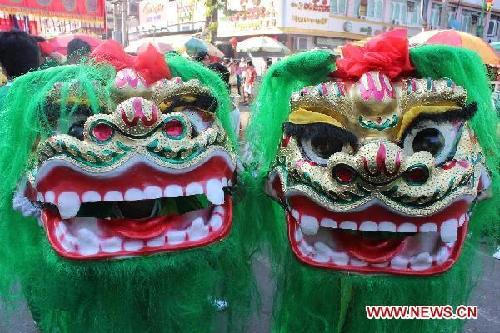 This photo taken on Jan. 22, 2012 shows the puppet lion heads at the Chinatown in Yangon, Myanmar. A celebration was held Sunday at the Chinatown in Yangon for the upcoming Chinese lunar New Year, which falls on Jan. 23 this year. (Xinhua/U Aung)
This photo taken on Jan. 22, 2012 shows the puppet lion heads at the Chinatown in Yangon, Myanmar. A celebration was held Sunday at the Chinatown in Yangon for the upcoming Chinese lunar New Year, which falls on Jan. 23 this year. (Xinhua/U Aung)
A grand lion and dragon dance performed by Chinese-Myanmar dancing groups opened up the Chinese New Year celebration in Myanmar's commercial city of Yangon Sunday, the eve of the Chinese Year of the Dragon.
With large traditional drums beating and colorful festive flags flying, the round-the-Chinatown dancing procession made up by 24 amateur lion and dragon dancing groups attracted thousands of watchers on Sunday afternoon.
As in the previous years, the marchers paid homage to the Chinatown Guangdong Guanyin (God of Mercy) Temple and Fujian Qingfu Gong Temple with on-the-spot brief performance when they passed by.
The two ancient temples of over a century of history represent the two largest Chinese temples in the Yangon Chinatown.
The procession began from the Sint Oh Dan Street in the heart of the Chinatown which is one of the most crowded places in Yangon and a commercial center.
As it passed noon, traffic on the main road in the Chinatown, which had been partially blocked for three days by temporary roadside stalls for selling new year goods, returned to normal, making way for the procession.
During the day of the new year eve, family members used to come back home from wherever they were for the reunion-lunch or dinner.
Families of Chinese residents prepared their meal rich with meat, especially pork, chicken, duck, wine and beverages, and had their meal deliciously after paying worship to their ancestors.
Chinese-Myanmar families used to erect the signboard of their ancestors on the wall of their apartments for worship, burn sticks and paper-money of gold and silver and offer liquor and a variety of food with their worship to pay respects to their ancestors according to traditional customs.
Most of their ancestors drifted away from the homeland in war time dating back to the Qing Dynasty when the first generation of Chinese citizens migrated to various parts of the world including Myanmar's Yangon by waterways.
Children are wearing colorful new clothes. They will visit relatives and close friends with their parents on Monday, the first day of the new year. Children are naturally joyful and encouraged as they will be offered by elders "Hongbao" (red envelops) as pocket money.
Some family members are also prepared to spend the night of the new year eve by staying up late or all night at home or at temples to observe the coming of the new year.
A series of lion dance competitions, involving the 24 amateur lion dancing groups, will take place on the Sint Oh Dan Street. The contests will run from the second day of the new year for three consecutive nights until Thursday, Jan. 26, and a prize- presentation ceremony will be held on Friday, Jan. 27, when the dancing groups will repeat their excellent performances.
Several other lion and dragon dance groups are also preparing to launch performances at some Chinese temples, international schools, famous parks and private companies respectively starting from the first day of the new year.
For the past week as the lunar new year was drawing near, many Chinese-Myanmar communities launched their respective traditional charity activities with several social and religious organizations such as Fujian Qing Fu Gon Temple, Guangdong Guan Yin Temple and Mutai Temple, distributing cash aid to the poor people above 75 years of age with no children to care for them.
Other local Chinese cultural associations are also due to launch big cultural shows on the new year days as annual festive get-togethers.
Source: Xinhua
Editor: Xu Xinlei
|


